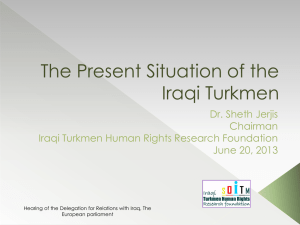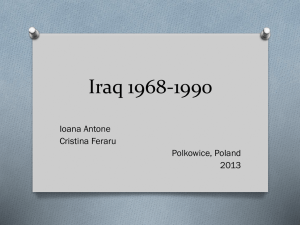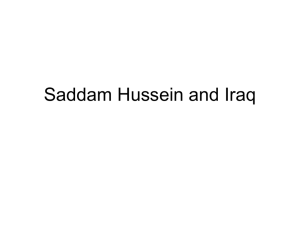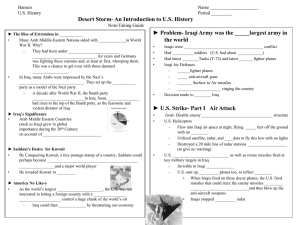Iraq
advertisement
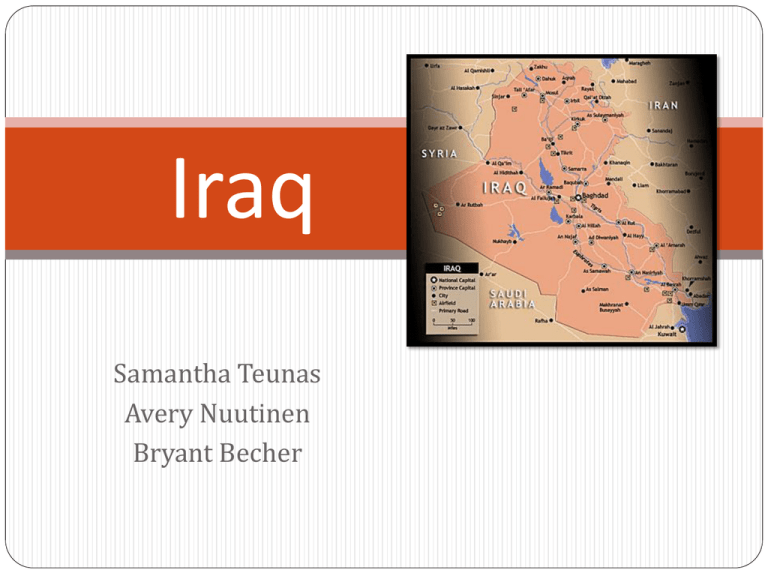
Iraq Samantha Teunas Avery Nuutinen Bryant Becher Water Use per Capita (m³) 3000 2500 2000 1500 1000 500 0 Iraq United states Water Usage Analysis Based on the bar graph shown previously, Iraq uses about twice as much water as the United States. It is estimated that both countries will develop a higher water scarcity within the next decade which might result in the graphs equaling out more. Iraq’s Biome Biome Temperate grasslands Steppe Grasses as dominant Dry grassland vegetation Varying temperatures Seasonal drought/occasional fires Plowing/grazing loose Deserts Savannas Hot/dry Shortage of precipitation Unbearable temperatures Barren land soil dust storms Climate Iraq climate varies greatly throughout the year, with the highest temperature varying from 100-120 degrees Fahrenheit. Within the winter months, the area temperature is below freezing with much snow. The average rainfall per year reaches around 100 centimeters. Rainfall usually occurs in the more mountainous regions of Iraq in the early spring and winter. Besides rain, Iraq’s summer season is marked by heavy winds. The two types of wind are classified as the southern and southeasterly Sharqi and the steady Shamal wind. The winds provide both dry heat as well as a possible cooling effect depending on the time of year. These winds bring hazardous dust storms which overall play a role in the water availability of Iraq. Average Temperatures of Iraq (C˚) How does Climate Affect Water Availability? The dry climate of Iraq can directly affect water availability. Based on the common dust storms as a result of the heavy winds, it leaves much dry land. Iraq has around 30 percent desert making up its landscape with over 50 percent being sub-deserts. Dust storms also affect water quality of most rivers and streams located in certain areas. The high temperatures that come with the summer months, affect the water level of Iraq’s water sources (Tigris & Euphrates River). Iraq also suffers from heavy droughts in the late summer months. Iraq Population/ Water Availability Iraq has a high population growth rate. The rate is almost twice the world’s population growth rate. Based on the World Bank, World Development Indicator, the population in Iraq increases by about 2.45 million per every five years with the rate steadily rising. From 2005 to 2010 the rate increased by 5.67 million to result in Iraq’s population being 32.03 as of 2010. This high population growth rate directly affects Iraq’s water availability. As the population increases, water availability per-capita decreases. It also influences the amount of water waste as well as water quality of area sources. Main Concerns Regarding Water Availability Iraq’s main concern regarding water availability right now is providing safe water to households. As of right now, 20% of homes in Iraq are being tapped unsafe water. Less than 50% of homes in rural areas have access to a safe water supply. A second main concern they house is that 16% don’t even have the ability to receive water. Access to Safe Drinking Water (Percentages) No Access Daily Problems Weekly Less than Weekly Serious Water Problems Iraq houses numerous water problems all over the country. As discussed earlier, water shortages per home are incredibly common as well as the use of hazardous water. A major concern is that the quality of most water is poor due to the contamination from sewage. Based on the Ministry of Water Resources in Iraq report of water in 2010, over 80% of households do not treat their water. Another big distress over water is that Iraq cannot use much of its groundwater due to the pollution as a result of the continual growth in population. Foreign Competition Iraq is currently involved in an argument over the use of water from the Tigris and Euphrates Rivers. Although they originate in Turkey, they are an important water source for both Syria, and Iraq. All of these countries use both the rivers for agricultural practices, hydroelectric power, and industrialization. Besides these common uses of water, the Tigris and Euphrates also serve a major role in supplying most of the countries basic water supply. Due to the extremity of this situation, the countries security systems are involved in the Tigris Euphrates Dispute. Water Strategic The Tigris Euphrates Dispute helped answer the main question: Who is entitled to the water and how can downstream countries be protected? An agreement was reached that Syria has to give Iraq 58% of its water received from Turkey per year. This resolution won’t be in effect for long due to the fact Iraq’s water usage is predicted to increase by three times in ten years. All of this and more are gaining much recognition from political/socialists in the Middle Eastern Countries which is leading to the study and focus of how we can make changes as well as come to a compromise. Water Action Plans Ideas Counteract Legal limit on number of Affects family, gender, children Apply for higher percentage of water received from nearby water sources/from surrounding countries Discover a way to begin harboring rainwater; work towards a new freshwater source and census statistics The application and permission process would take too long for approval within Iraq’s government Climate affects the sanity of water (dust storms); average rainfall varies widely Water Action Plan Whole House Water Filter • Unsafe drinking water • Health statistics • Architectural practices • Blueprint • Home improvement Connects to main water line and filters every source of water.
